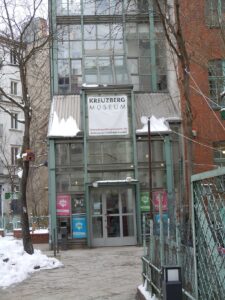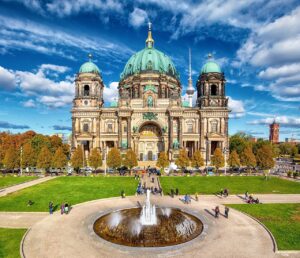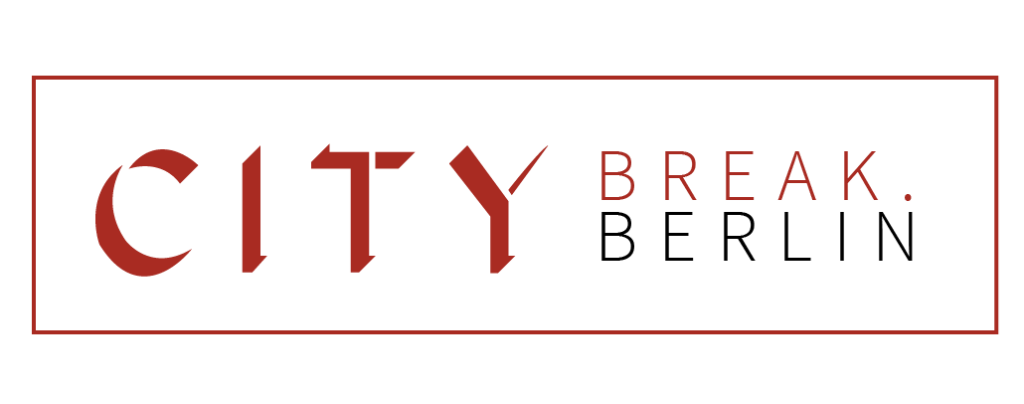The American Zone of Occupation
Imagine this: the trendy, even edgy, café you’re sitting in today, in Berlin’s diverse Kreuzberg district, was just a few decades ago within the largest besieged city in world history, West Berlin. The barista then might have been a counter-culture rebel escaping from mandatory military service in West Germany. The next couple of streets over were patrolled by Communist security forces and they kept this isolated western outpost under close watch. Welcome to what was once the American Zone of Occupation in Berlin, a pivotal chess square in the sometimes deadly game known as the Cold War.
Today, Berlin is unified. But from 1945 to 1990, it was a divided city within a divided Germany. The American Sector wasn’t just a slice of the occupied city. It was a frontline, a cultural hub, and a symbol of the U.S.’s postwar presence in Europe. And remarkably, you can still visit some of the key sites.

The American Sector: Borders and Limits
It’s worth saying a few words about the status of West Berlin, including the American, French and British sectors, since it can get confusing. After 1949, West Berlin and its three sectors sat in a strange in-between zone. It was geographically inside East Germany, politically tied to West Germany, but still legally under Allied occupation. While West Berlin had its own elected mayor and parliament, ultimate authority remained in the hands of the American, British, and French military commanders. West Berlin wasn’t officially part of West Germany, and it certainly wasn’t a NATO city. It lived under the shadow of four-power agreements made back in the closing days of World War II.
That said, day-to-day life in West Berlin felt much like life in any other Western democracy. The streets were policed by local forces, schools were run by Berliners, and the city was deeply connected, economically and culturally, to West Germany. West Berliners used the Deutsche Mark, enjoyed freedom of the press, and even watched West German television. But their city remained under military jurisdiction until reunification in 1990. It was a place where democracy thrived, but under a watchful Allied and Soviet eye. Remember, the western military powers and the Soviets authorities each had the right to go wherever they wanted in each other’s sectors. As I say, a recipe for confusion!
A Brief Look at the American Presence
When U.S. forces entered Berlin in July 1945, they were latecomers to a city already occupied by the Soviets. But from the start, the American military and political presence was assertive. Lucius D. Clay, Military Governor of the U.S. Zone, played a major role in postwar governance and in the development of the Marshall Plan, which helped rescue West Germany from the ruins of the war and ultimately point them in a firmly anti-Soviet direction.
The Americans set up their command at Hüttenweg 100 in the district of Zehlendorf. One of Clay’s great achievements was the overseeing of the Berlin Airlift of 1948-1949, when American and British planes kept West Berlin supplied during the Soviet blockade. His statue now stands outside the former headquarters.
The American Sector of West Berlin became a bastion of Western ideals, commerce, and culture. It housed not just U.S. military installations, but also American schools, libraries, and radio stations. The Rundfunk imamerikanischen Sektor (RIAS), or Broadcasting in the American Sector, was launched in 1946 and became a key tool in countering Soviet messaging.
Throughout the Cold War, the American Sector was a site of military tension, espionage, and protest. Indeed, before the Wall went up in 1961, Berlin was without question the spy capital of the world. But the American Sector was also a lively place to live. U.S. troops maintained a high profile, and Kreuzberg became a hub for counterculture and dissent, especially during the Vietnam War era.
The fall of the Berlin Wall in 1989 and the reunification of Germany in 1990 marked the end of the occupation. But the American influence remains visible, if you know where to look.
What You Can See Today: Walking the American Zone
1. Checkpoint Charlie (Friedrichstraße 43-45)
The most iconic symbol of the American Sector, Checkpoint Charlie was the best-known crossing point between East and West Berlin. It was the scene of several Cold War showdowns, including the famous 1961 tank standoff between Soviet and American forces, when we were within a few heartbeats of WW3 breaking out.
The site today has changed beyond all recognition. The DDR side of the checkpoint has entirely vanished and has been mostly built over; you’d never know it had been there unless you looked at old photos and maps. The atmosphere, therefore, is utterly different from the old days. Put aside any notions of sensing the ghosts of spies and Cold War tensions. Today it’s a modern traffic intersection, jammed full of tourists, pickpockets, and a handful of terrible «reconstructions.» Go there if you want to say you’ve seen the site, and the two museums nearby are worth visiting (try to visit off peak hours) but otherwise, to my taste, it’s a fascinating example of how not to manage what we’ve come to call «heritage.» But that’s probably an argument left to another blog!
2. Allied Museum (Clayallee 135)
Housed in former U.S. military buildings in the Zehlendorf district, the Alliierten Museum showcases the history of the Allied presence in Berlin. It includes a segment of the Berlin Wall, a U.S. Army train car, and the original guardhouse from Checkpoint Charlie.
A highlight is the exhibition on the Berlin Airlift, including a «candy bomber» plane used to drop supplies—and sweets for children—into West Berlin. Entry is free, but as of 2025, check to make sure the renovation is complete. Parts of the exhibit have remained open, but check in advance to be sure.
3. Tempelhof Airport (Platz der Luftbrücke 5)
Flughafen Tempelhof was the centerpiece of the American logistical effort during the Berlin Airlift. Closed to air traffic in 2008, it’s now a massive public park where you can bike, picnic, and explore remnants of its military past.
Guided tours of the historic terminal are available and offer access to old Nazi-built bunkers, Cold War fallout shelters, and the airlift operations areas. Look for the Berlin Airlift Memorial just outside the main entrance.
4. Checkpoint Bravo (Dreilinden-Direkt)
Less known than Checkpoint Charlie, Checkpoint Bravo was one of the outer checkpoints on the Autobahn between West Berlin and West Germany proper. It controlled access to the highway through the DDR, thus forming the checkpoint for cars between East Germany and West Berlin.
The original site at Dreilinden has a small historical display and remnants of the American military checkpoint, though thankfully it’s not as developed as Checkpoint Charlie. In fact, it’s a fascinating, off-the-beaten-path site which retains the memory of the 1970s and 1980s far better than Checkpoint Charlie.
5. Amerikahaus and RIAS Building (Hardenbergstraße 22–24)
Once the heart of American cultural diplomacy in Berlin, Amerikahaus was home to exhibitions, concerts, and a library promoting U.S. values during the Cold War. It now houses the C/O Berlin photography museum, but the building retains its historical significance.
Just nearby at Hans-Rosenthal-Platz, you’ll find the former RIAS radio station, now part of Deutschlandradio. The building helped beam «the American voice» into East Berlin and was critical in broadcasting uncensored news and music across the Iron Curtain.
6. The Kurfürstendamm
Walk along the «Ku-damm» and hang out around the bomb-damaged Kaiser Wilhelm Memorial Church. You’re standing and walking along what was the real beating heart of West Berlin. This became the de facto center of the city for the Western forces and stood in stark contrast to the Alexanderplatz and the Karl-Marx Alee in the Eastern Sector. Here the lights were bright, fashion was of the latest, and people enjoyed crowd-pleasing shows in the theaters, not to mention the newest and trendiest cafes and restaurants. The area still has that bohemian, up-market atmosphere today, and this is perhaps the longest tangible legacy of those years of division.
Although Berlin is no longer a city walled-off and surrounded by hostile forces, the great thrill of walking around West Berlin today is that you can still capture echoes of the old days. People drinking colas and visiting western fast-food outlets, the loud brash ideas for new business ventures being hammered out in fancy cafes and the underlying belief that Berlin stands for freedom; all these are partly or directly traceable back to West Berlin and the mood in the former American sector. Enjoy your exploration, there is certainly a huge amount to discover.




